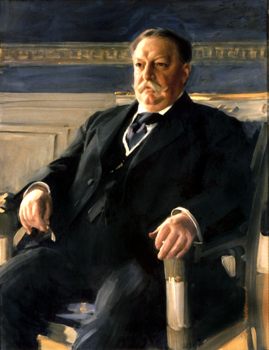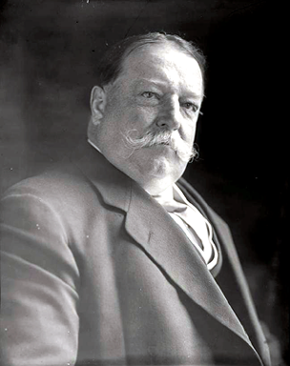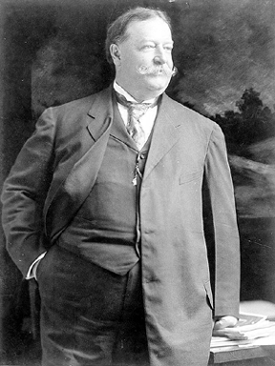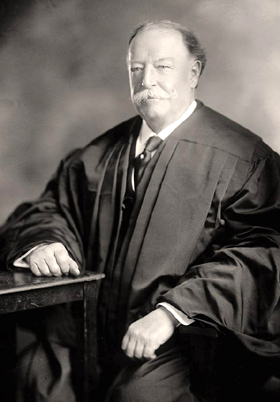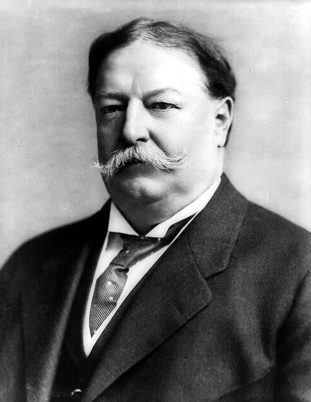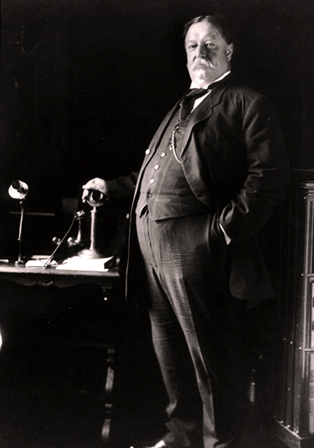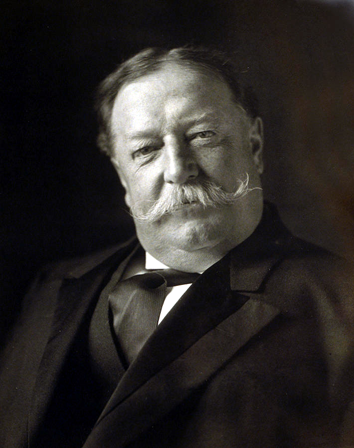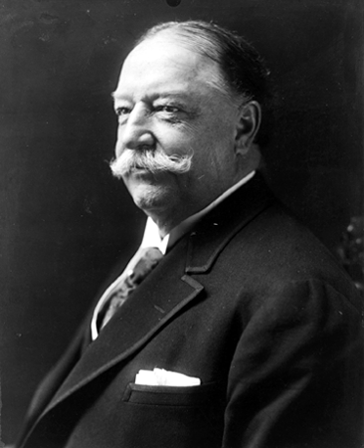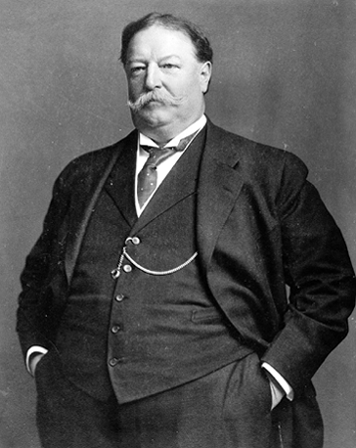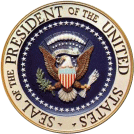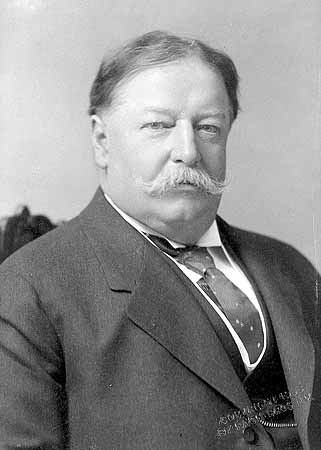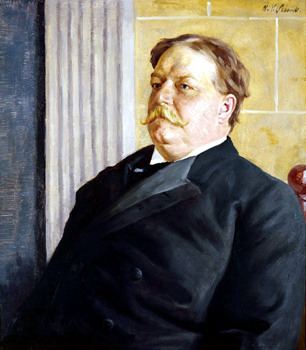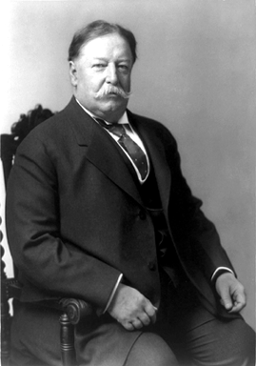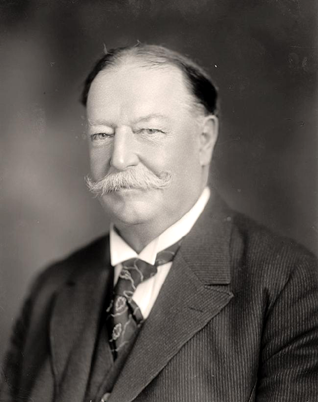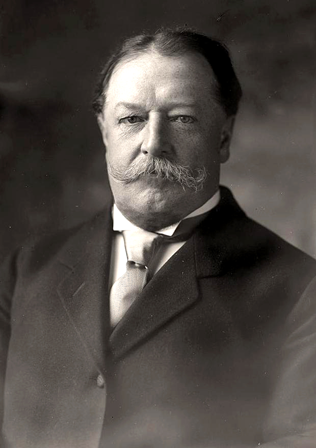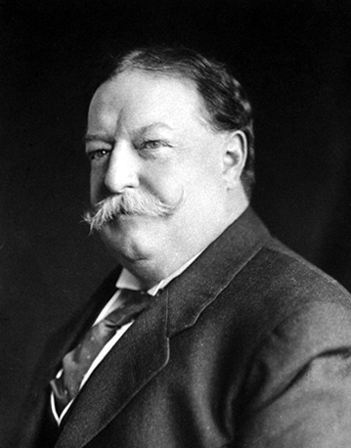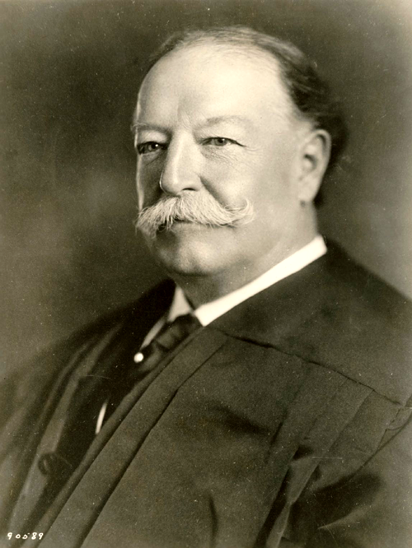|
WILLIAM HOWARD TAFT |
|
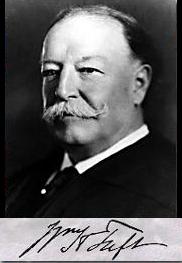
THE 27TH PRESIDENT OF
THE UNITED STATES OF AMERICA
(1909-1913)
TAFT, William Howard
(1857–1930), 27th president of the U.S. (1909–13) and 10th chief justice of the U.S. (1921–30); he was the only person in U.S. history to head two branches of the federal government.The son of a leading Ohio lawyer and politician, Taft was born on Sept. 15, 1857, in Cincinnati, Ohio. He studied at Yale University, graduating second in his class in 1878, and at the Cincinnati Law School, receiving his degree and commencing practice in 1880. Taft moved rapidly up through appointive offices, as assistant district attorney and internal revenue collector in Cincinnati in the early 1880s, later as a state judge, then as solicitor general of the U.S. (1890–92) and judge of the Circuit Court of Appeals (1892–1900). He was an able lawyer and a jurist of moderately progressive social views, and he formed political connections and lasting friendships, the most important of which were with the future presidents William McKinley and Theodore Roosevelt. In 1886 he married Helen Herron (1861–1943) of Cincinnati, who became his astute adviser and prodded him to pursue lofty ambitions. Their three children all distinguished themselves in public service: Robert, as U.S. senator from Ohio and as a Republican leader; Helen (1891–1987) as dean of Bryn Mawr College; and Charles (1897–1983) as mayor of Cincinnati. One of Taft’s grandsons also served as U.S. representative and senator from Ohio.
Rise to Prominence.
In 1900 President McKinley appointed Taft head of the commission to govern the Philippines, and the following year he became the islands’ first civilian governor, a post he filled admirably, setting up judicial and local government systems, starting social services, and dealing with native leaders and Roman Catholic church officials over land disposition. His work drew favorable attention from the U.S. press and made him a popular national figure. In 1904 President Roosevelt named him secretary of war, a position from which he continued to supervise the Philippines, directed construction of the Panama Canal and started government in the Canal Zone, and contributed to the modernization of the army. Taft also helped to conduct the negotiations that ended the Russo-Japanese War in 1905, and he traveled to the Far East to settle a conflict with Japan over the exclusion of Oriental immigration. Twice he declined Roosevelt’s offers of a seat on the Supreme Court, which he wanted, because his wife persuaded him to remain available for the presidency. Receiving Roosevelt’s nod for the 1908 Republican nomination, he capitalized on the incumbent’s winning popularity and the party’s strength, easily defeating the Democratic nominee, William Jennings Bryan.
Taft as President.
Taft was not a successful president, both because he faced a difficult situation and because he lacked political gifts. A deepening division within the Republican party between progressives and conservatives, which Roosevelt had smoothed over and evaded, dogged his administration from the outset. Taft’s attempt in 1909 to revise the protective tariff, which had grown increasingly unpopular, became a fiasco when conservative Republican senators subverted the legislation. Taft, however, failed either to work out compromises or to fight for his program, and he alienated his former progressive supporters. Relations with progressives deteriorated further in 1910, when, after a complicated administrative struggle, Taft fired the chief of the Forest Service, Gifford Pinchot, the nation’s leading conservationist and a friend of Roosevelt. Republican unity collapsed in the 1910 primaries when Taft unsuccessfully opposed several progressives supported by Roosevelt, and they and the Democrats scored big victories in the fall elections. Those conflicts doomed the Taft administration politically, although it did compile a number of accomplishments, including establishment of the Federal Children’s Bureau, vigorous antitrust prosecutions of big business, and a restrained, pacific foreign policy. Taft suffered a severe personal and political blow early in his term when his wife was partially incapacitated by a stroke (1909).
Taft’s presidency might have ended quietly if Roosevelt had not run against him in 1912. Siding with progressive dissidents, Roosevelt won most of the primaries but lost the Republican nomination because Taft controlled the party machinery. Charging a "steal," Roosevelt then bolted to head the third-party Progressive (Bull Moose) ticket. By this time, Taft regarded Roosevelt as a dangerous demagogue, especially because of his criticism of court decisions, and he stayed in the presidential race without hope of winning, only to keep Roosevelt from being elected. Although he finished behind Roosevelt, carrying only Utah and Vermont, Taft split the usual Republican vote and threw the election to the Democratic nominee, Woodrow Wilson. He was pleased at the outcome and left the White House with undisguised relief.
Medical conditions and weight.
Taft is often remembered as being the most obese president. He was 5 feet, 11.5 inches tall; his weight peaked at 335–340 pounds toward the end of his Presidency. The truth of the often-told story of Taft getting stuck in a White House bathtub is unclear.
Evidence from eyewitnesses, and from Taft himself, strongly suggests that during his presidency he had severe obstructive sleep apnea. His chief symptom was somnolence. While President, he fell asleep during conversations, and at the dinner table, and even while standing. He was also strikingly hypertensive, with a systolic blood pressure over 200.
Within a year of leaving the presidency, Taft lost approximately 80 pounds (36 kg). His somnolence problem resolved and, less obviously, his systolic blood pressure dropped 40–50 mmHg (from 210 mmHg). Undoubtedly, this weight loss extended his life.
Soon after his weight loss, he had a revival of interest in the outdoors; this led him to explore Alaska. Beginning in 1920, Taft used a cane; this was a gift from Professor of Geology W. S. Foster, and was made of 250,000-year-old petrified wood.
Later Career.
Taft’s years as ex-president were among his happiest and most productive. In 1913 he became a professor at Yale Law School and finally succeeded in reducing his renowned weight below 300 lb. He remained active in the Republican party, and although he criticized Wilson’s domestic policies from an increasingly conservative stance, he supported his successor’s foreign policies and in 1915 headed the League to Enforce Peace, which advocated a league of nations before Wilson did. After the U.S. entered World War I in 1917, Wilson appointed Taft cochairman of the National War Labor Board, and when the Republicans regained the White House in 1921, President Warren G. Harding named him chief justice of the U.S., fulfilling Taft’s long-held dream. Taft became one of the great chief justices in the history of the Supreme Court. He again showed his administrative ability by reducing the Court’s backlog and securing passage of the Judiciary Act of 1925, which gave the justices more control over the selection of cases to be heard. Taft also impressed his judicial views on the Supreme Court, forsaking his own earlier progressivism for a more conservative stress on property rights and governmental limitation. A majority of the justices retained his viewpoint until the late 1930s.
Death and legacy.
Taft retired as Chief Justice on February 3, 1930, because of ill health. Charles Evans Hughes, whom he had appointed as an Associate Justice while President, succeeded him as Chief Justice.
Five weeks following his retirement, Taft died on March 8, 1930, in Washington, D.C., the same date as Associate Justice Edward Terry Sanford's unexpected death. As it was customary for members of the court to attend the funeral of deceased members, this posed a "logistical nightmare", necessitating cross-country travel. The house at which Taft died is now the diplomatic mission of the Syrian Arab Republic to the United States.
Three days following his death, on March 11, he became the first president to be buried at Arlington National Cemetery. James Earle Fraser sculpted his grave marker out of Stony Creek granite. Taft is one of two presidents buried at Arlington National Cemetery, and is one of four Chief Justices buried there. Taft was the only Chief Justice to have had a state funeral.
In 1938, a third generation of the Taft family entered the national political stage with the election of the former President's oldest son Robert A. Taft I to the Senate, where he became a leader of the conservative Republicans. President Taft's other son, Charles Phelps Taft II, served as the mayor of Cincinnati from 1955 to 1957.
Two more generations of the Taft family later entered politics. The President's grandson, Robert Taft, Jr., served a term as a Senator from Ohio from 1971 to 1977, and the President's great-grandson, Robert A. "Bob" Taft II, served as the Governor of Ohio from 1999 to 2007. William Howard Taft III was the U.S. ambassador to Ireland from 1953 to 1957.
William Howard Taft IV, currently in private law practice, was the general counsel in the former United States Department of Health, Education, and Welfare in the 1970s, was the Deputy Secretary of Defense under Caspar Weinberger and Frank Carlucci in the 1980s, and acted as the United States Secretary of Defense during its vacancy from January to March 1989. In addition, he served as Legal Adviser at the Department of State from 2000 to 2006.
President Taft's enduring legacy includes many things named after him. The William Howard Taft National Historic Site is the Taft boyhood home. The house in which he was born has been restored to its original appearance. It includes four period rooms reflecting family life during Taft's boyhood, and second-floor exhibits highlighting Taft's life. Others include the courthouse of the Ohio Court of Appeals for the First District in Cincinnati; streets in Cincinnati, Arlington, Virginia; and Taft Avenue in Manila, Philippines; a law school in Santa Ana, California; and high schools in San Antonio, Texas; Woodland Hills, California; Chicago, Illinois; and The Bronx. Taft, Eastern Samar, a town in the Philippines was named after him. After a fire burned much of the town of Moron, California, in the 1920s, it was renamed Taft, California, in his honor.
George Burroughs Torrey painted a portrait of him. Taft is the last President to have sported facial hair while in office.
